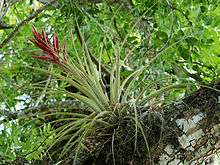Tillandsia
| Tillandsia | |
|---|---|
 | |
| Tillandsia fasciculata | |
| Scientific classification | |
| Kingdom: | Plantae |
| (unranked): | Angiosperms |
| (unranked): | Monocots |
| (unranked): | Commelinids |
| Order: | Poales |
| Family: | Bromeliaceae |
| Subfamily: | Tillandsioideae |
| Genus: | Tillandsia L. |
| Species | |
|
Over 650 species | |
| Synonyms[1] | |
| |

Tillandsia is a genus of around 650 species of evergreen, perennial flowering plants in the family Bromeliaceae, native to the forests, mountains and deserts of Central and South America, the southern United States and the West Indies.[2] They have naturally been established in diverse environments such as equatorial tropical rain forests, high elevation Andes mountains, rock dwelling (saxicolous) regions, and Louisiana swamps, such as the usneoides (Spanish Moss) species growing atop tree limbs. Airplant is a common name for plants in this genus.[3] Most Tillandsia species are epiphytes – i.e. they normally grow without soil while attached to other plants. Some are aerophytes or air plants, which have no roots and grow on shifting desert soil.[4] Generally, the thinner-leafed varieties grow in rainy areas and the thick-leafed varieties in areas more subject to drought. Most species absorb moisture and nutrients through the leaves from rain, dew, dust, decaying leaves and insect matter, aided by structures called trichomes.
Description
Tillandsias are epiphytes and need no soil because water and nutrients are absorbed through the leaves.[5] The roots are mainly used as anchors. Propagation is by seeds or by offsets called "pups". A single plant could yield up to a dozen pups. Offsets can be separated when about 2/3 the size of their mother to encourage a new colony.
Although not normally cultivated for their flowers, some Tillandsia will bloom on a regular basis. However, while some may exhibit a spectacular inflorescence, most flowers are generally small. The flowers of some species may change color through the blooming cycle. Some species or varieties produce fragrant flowers. In addition, it is quite common for some species to take on a different leaf color (usually changing from green to reddish tones), called "blushing", when about to flower. This is an indication that the plant is monocarpic (flowers once before dying) but offsets around the flowering plant will continue to thrive. Blushing also signifies ripe time for pollination, aided by animals such as hummingbirds. Many Tillandsia species are thus naturally hybridized by visiting pollinators or the wind. Many new hybridized Tillandsia species and cultivars are products of human growers.
Most Tilandsias are adaptive and hardy enough to be grown indoors with adequate lighting and care, with most types not requiring any soil or such planting medium. Many enthusiasts may attach these plants to other objects. Indoor grown Tillandsias generally need to be watered about 1-3 times a week, often by spraying the plant, and occasional feeding with watered down orchid fertilizer. Depending on the species, regular dunking in water may be essential to maintaining their health as well. However, in nature, Airplants get plenty of air movement to help them dry fast enough, for they are highly susceptible to mold and decay otherwise.
Some Tillandsia species closely resemble one another, while some tend to change form as they mature. Therefore, a displaced pup may be very difficult to identify, and some species may even be impossible to ID by looks alone even when in bloom.
Taxonomy
The genus Tillandsia was named by Carl Linnaeus after the Swedish physician and botanist Dr. Elias Tillandz (originally Tillander) (1640–1693). Some common types of Tillandsia include air plant, ball moss (T. recurvata) and Spanish moss, the latter referring to T. usneoides in particular. The genus contains around 730 species,[6] traditionally divided into seven subgenera:[7]
- Tillandsia subg. Allardtia (A. Dietr) Baker
- Tillandsia subg. Anoplophytum (Beer) Baker
- Tillandsia subg. Diaphoranthema (Beer) Baker
- Tillandsia subg. Phytarrhiza (Vis.) Baker
- Tillandsia subg. Pseudalcantarea Mez
- Tillandsia subg. Pseudo-Catopsis Baker
- Tillandsia subg. Tillandsia
Four species are protected under CITES II:[8]
- Tillandsia harrisii
- Tillandsia kammii
- Tillandsia mauryana
- Tillandsia xerographica
Ecology
Species of Tillandsia grow through a process called CAM cycle, where they close their stomata during the day to prevent water loss and open them at night to fix carbon dioxide and release oxygen.[9] Temperature is not critical, the range being from 32 °C (90 °F) down to 10 °C (50 °F). They are sensitive to frost, except for the hardiest species, T. usneoides, which can tolerate night-time frosts down to about −10 °C (14 °F).
References
- ↑ "World Checklist of Selected Plant Families".
- ↑ RHS A-Z Encyclopedia of Garden Plants. United Kingdom: Dorling Kindersley. 2008. ISBN 1405332964.
- ↑ "Tillandsia". Natural Resources Conservation Service PLANTS Database. USDA. Retrieved 10 December 2015.
- ↑ Galán de Mera, A., M. A. Hagen & J. A. Vicente Orellana (1999) Aerophyte, a New Life Form in Raunkiaer's Classification? Journal of Vegetation Science 10 (1): 65-68
- ↑ Isley, Paul T. (2009). Tillandsia II : the world's most unusual airplants. Redondo Beach, Calif.: Botanical Press. ISBN 0981701019.
- ↑ "The Plant List". Retrieved 21 December 2014.
- ↑ Tania Chew, Efraín De Luna & Dolores González (2010). "Phylogenetic relationships of the pseudobulbous Tillandsia species (Bromeliaceae) inferred from cladistic analyses of ITS 2, 5.8S ribosomal RNA gene, and ETS sequences" (PDF). Systematic Botany. 35 (1): 86–95. doi:10.1600/036364410790862632. Archived from the original on March 23, 2015.
- ↑ "Appendices I, II and III valid from 5 February 2015*". CITES. Retrieved 23 February 2015.
- ↑ David H. Benzing (2008). Vascular Epiphytes: General Biology and Related Biota. Cambridge University Press. p. 53. ISBN 9780521048958.
External links
 Media related to Tillandsia at Wikimedia Commons
Media related to Tillandsia at Wikimedia Commons